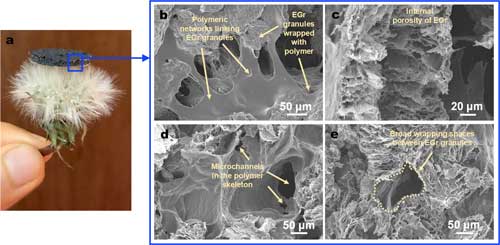Ultra-lightweight foam uses sunlight to collect water from evaporation
QQ Academic Group: 1092348845
Detailed
Demand for these scarce water resources is growing even faster than energy demand. Currently, an estimated 2 billion people are facing water shortages. According to the future population growth rate, by 2030, 2.7 to 3.2 billion people may be living in or without water.
Around the world, research teams such as the “Smart Materials” research group at the Italian Institute of Technology in Genoa are meeting the growing global demand for water by developing sustainable and direct technologies using natural resources.
"Our goal is to reduce the use of chemicals and complex and energy-intensive systems," said Despina Fragouli, a team scientist responsible for water research.
"In addition, we have noticed that the intensity and frequency of natural disasters are increasing, so we are eager to develop highly portable water technologies to quickly deploy them to ensure the survival of disaster victims." Loo, postdoc developed in collaboration with Fragouli Alternative water technologies to address global water security issues.
Loo is the first author of the paper on ACS Applied Materials and Interfaces ("Atmospheric Moisture Generated by Solar Water and Hydrophilic Photothermal Foam to Generate Solar-Driven Fresh Water"). The Institute‘s IIT team reports a And the self-floating photothermal foam shows high evaporation rate without the need for additional ingredients, thus providing an elegant and simple method for collecting water through solar evaporation.

(A) The photo shows HEPF (hydrophilic enhanced photothermal foam) standing on a dandelion, demonstrating its lightweight properties. The SEM image shows the layered pore structure of (b) surface and (ce) cross section of HEPF. (Reprinted with permission from the American Chemical Society) (click image to enlarge)
"Evaporation of the sun is a strategy to solve the problem of water scarcity, because the sun has a lot of potential energy, and if properly collected, it can provide sustainable energy for the process," Loo told Nanowerk. "Not only does this have a large amount of seawater and a large amount of steam trapped in the atmosphere, it also makes the solar-induced evaporation process using our foam an attractive alternative technology to meet global water demand in various situations."
Photothermal foam-a three-dimensional framework of expanded graphite contained in a polymer network of polyurethane and sodium polyacrylate-achieves an elegant and simple method of collecting water by utilizing the energy in natural sunlight.
The research team points out that foam prepared by a simple, cost-effective and highly scalable method can be used not only to collect water from seawater, but also to collect water from atmospheric moisture, which is an untapped alternative in freshwater production Resources. . They believe that this is the first study to closely combine all the ideal characteristics of solar evaporation, water collection, and atmospheric water collection.
The ability to produce fresh water from a variety of sources is highly correlated with situations where there is a high degree of uncertainty about the availability and quality of the source water, which is typical after a disaster.
The lightness, versatility and simple operability of the foam show that it can be an effective water collection solution for off-grid applications such as emergency drinking water response / disaster relief and providing fresh water with limited fresh water supply to remote communities.
It can therefore be incorporated into a portfolio of water solutions of interest to water policy makers and NGOs for implementation in programmes such as disaster preparedness and water supply in remote villages with limited fresh water supply. In addition to humanitarian uses, the foam can be developed into commercial products suitable for backpacking or hiking purposes.
"The versatility of our foam and high solar evaporation efficiency show that it is a promising solution that provides sufficient water, which is critical to the short-term maintenance and survival of the affected population," Lu said. Water treatment technology developed for such applications, but it is not typical to find a water treatment technology that is so simple to produce high-yield water while desalination and driven by natural sunlight alone. "
Looking ahead, the researchers plan to further simplify the manufacturing method of photothermal foam to ensure that this method can be easily used for large-scale manufacturing. They are also exploring a number of other low-cost materials. In particular, they are considering the use of porous materials from natural food and agricultural waste.
Another effort will be to further enhance the wettability and photothermal properties of the foam, which is essential to further increase the solar evaporation rate and moisture capture capacity.
"We also plan to develop multi-functional photothermal materials and extend their technology to treat industrial and domestic wastewater, which contains not only inorganic substances such as salts and heavy metals, but also volatile organic compounds that may escape with the steam and eventually escape. Distillate, "Loo said.
However, many materials scientists worldwide are working to improve solar thermal energy conversion efficiency and solar evaporation efficiency. With the efforts of these researchers, the results are encouraging.
"But another important aspect of collecting water through the solar evaporation process is the condensation of the generated steam," Loo concluded. "There is less research on the effects of the materials and structure of the condensing chamber on the efficiency of collecting condensing steam, and it is worth doing more research in this area to ensure that the water production rate is not limited by the condensing rate because significant solar evaporation rates are being achieved progress."
Source: nanowerk
- Previous: Materials Today: Large
- Next: 1


 About us
About us
